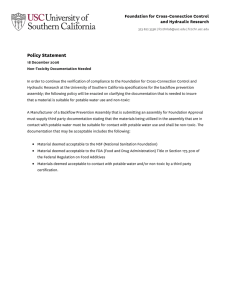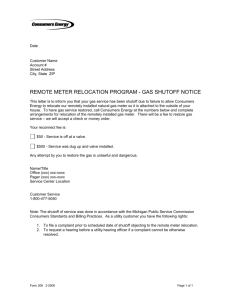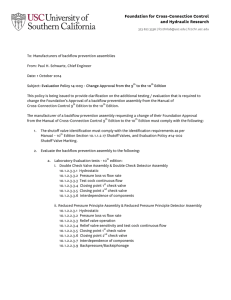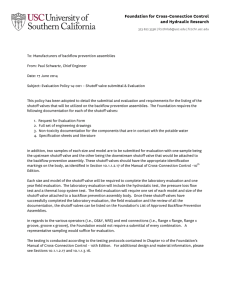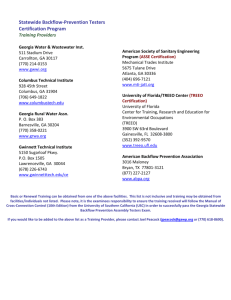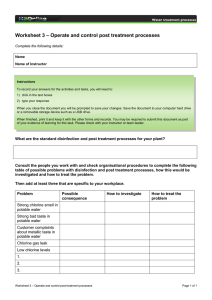Document 13107050
advertisement
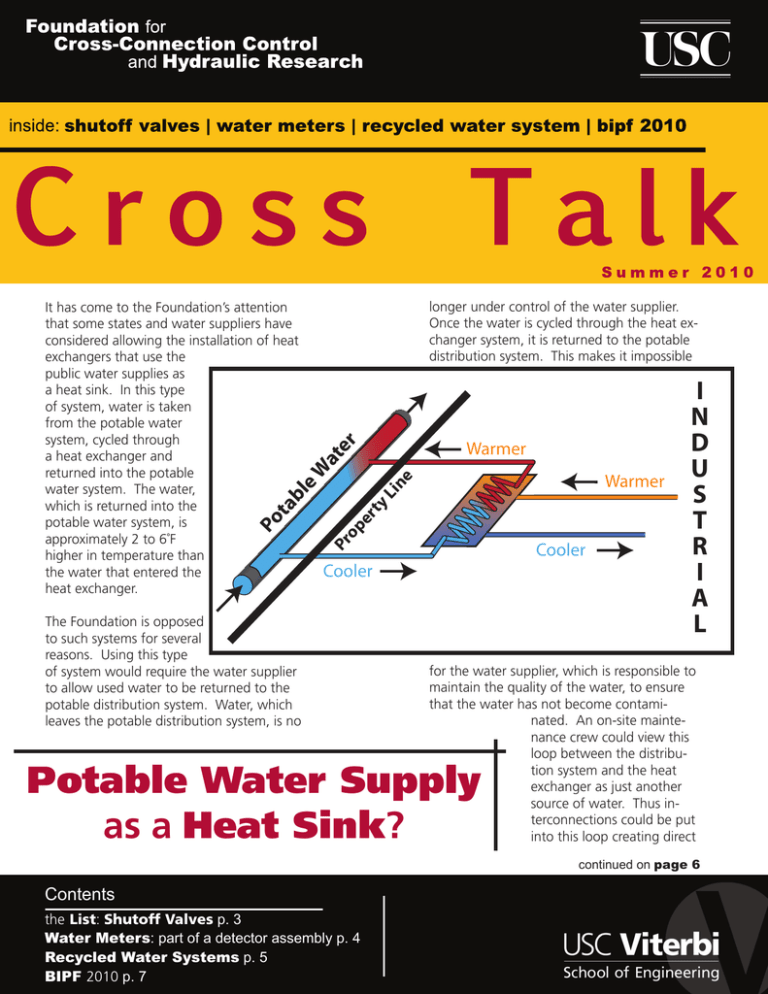
longer under control of the water supplier. Once the water is cycled through the heat exchanger system, it is returned to the potable distribution system. This makes it impossible Li le Pr op er ty ab Po t Warmer ne W at er Warmer Cooler Cooler The Foundation is opposed to such systems for several reasons. Using this type of system would require the water supplier to allow used water to be returned to the potable distribution system. Water, which leaves the potable distribution system, is no INDUSTRIAL It has come to the Foundation’s attention that some states and water suppliers have considered allowing the installation of heat exchangers that use the public water supplies as a heat sink. In this type of system, water is taken from the potable water system, cycled through a heat exchanger and returned into the potable water system. The water, which is returned into the potable water system, is approximately 2 to 6˚F higher in temperature than the water that entered the heat exchanger. for the water supplier, which is responsible to maintain the quality of the water, to ensure that the water has not become contaminated. An on-site maintenance crew could view this loop between the distribution system and the heat exchanger as just another source of water. Thus interconnections could be put into this loop creating direct Potable Water Supply as a Heat Sink? continued on page 6 Contents the List: Shutoff Valves p. 3 Water Meters: part of a detector assembly p. 4 Recycled Water Systems p. 5 BIPF 2010 p. 7 Foundation Membership The Foundation’s Membership Program provides many benefits to the Members of the Foundation. These include: a twenty-five percent discount on manuals, twenty percent discount on Foundation Training Courses for ALL EMPLOYEES of the Member company/organization, the List of Approved Backflow Prevention Assemblies with access to the up-to-the-minute version on the Foundation’s website. Below is a list of those who have become members of the Foundation since the last Cross Talk: Alaska Central Chapter IAPMO Jim Bustos Plumbing Arts Rural Water Service Judith Ximines Atlas Backflow Ken Russell Sprinkler Systems Backflow Management, Inc. Lakins Irrigation Backflow Prevention Services, Inc. Marine Corps Base- Camp Pendleton Beau Chene Homeowners Association Mars Petcare US, Inc. California Backhoe Service, Inc. Pipeline Backflow Services Christianson A/C & Plumbing Psycho Plumbing CMC Backflow Testing Rawlings Mechanical D.Lyle Setwyn, P.E. Rose Construction Group, Inc. Elmer Ostling South Coast Plumbing Group, Inc. Eric Wiebel Sundance Training Garden City Public Works The Blue Mountains, Town of Glendale- Parks Division, City of US Navy Greg Tate West Palm Beach, City of Gregg Walsten William Heuberger H2O WORKS Wilson Lee Hazzard Backflow Hirlekar Precision Engg. Pvt. Ltd. HPS Mechanical Cross Talk is published by the Foundation for Cross-Connection Control and Hydraulic Research at the University of Southern California for Foundation Members. 2010 © University of Southern California. All rights reserved. printed on Page 2 SUMMER 2010 Cross Talk recycled paper The List: Shutoff Valves The List of Approved Backflow Prevention Assemblies is an essential tool for many testers and cross-connection control specialists. The List offers, “lead free,” water meter, bypass and shutoff valve information. The after the original shutoff valve. Although, some assemblies may be shown on the List with no shutoff valves in parenthesis. Prior to May, 1993 the List of Approved Assemblies did not list acceptable shutoff valves. Only those shutoff valves submitted with the assembly when evaluated were acceptable. Unless requested by a manufacturer to test other shutoff valves, none were listed with the assembly. Therefore, some assemblies listed prior to May of 1993 may not have shutoff valves listed. In these cases it would be necessary to replace the shutoff valve on the assembly with the original model shutoff valve that the assembly shipped with to maintain approval. Foundation aims to arrange the List in a clear and understanding manner. Recently, members have enquired about the meaning of parenthesis found in the shutoff valve fields for approved assemblies. Presently, members may look up an approved assembly on the List and identify which shutoff valves are permitted with the assembly to maintain Foundation approval. In that list of shutoff valves, members have observed a shutoff valve in parenthesis. The shutoff valve in parenthesis indicates that the assembly was sent to the Foundation laboratory for evaluation with that specific shutoff valve installed. Other shutoff valves having similar performance characteristics that permit the assembly to comply with the Standard are shown on the List immediately There is only one other instance when a parenthesis may not be applicable. Once an approved backflow prevention assembly is no longer manufactured the device is listed as spare parts only. At that point only spare parts by the original manufacturer may be used to maintain the assemblies approval. Once the approved assembly is spare parts only, there is no longer an original shutoff valve designation. The original shutoff valve in parenthesis does not mean that the shutoff valve is considered better than any other shutoff valve listed along with that assembly. All shutoff valves listed will provide equivalent results. They all maintain the same level of protection and Foundation approval of that assembly. In most cases the shutoff valves found in parenthesis ship with the backflow prevention assembly from the manufacturer. If you have any more questions regarding the List, the Foundation encourages you to contact the office via phone or e-mail. g Cross Talk SUMMER 2010 Page 3 Water Meters: part of a detector assembly The Foundation periodically receives requests for information regarding “approved meters” for detector assemblies. It should be noted that the Foundation does not have a standard for meters, nor does the Foundation approve meters. The way specific meters operate determine if they may be used on Foundation approved detector backflow prevention assemblies. Detector assemblies have a mainline backflow prevention assembly with a bypass around the check valves (around the second check only on the Type II detector assemblies). The bypass arrangements contain a double check valve (for the DCDA), a reduced pressure principle assembly (for the RPDA), or a single check for the DCDA-IIs and RPDA-IIs. The meter is also located in the bypass line. The assemblies are designed so that the pressure lost through the main line assembly will be greater than the pressure loss through the bypass arrangement, forcing the water exclusively through the bypass assembly registering accurately on the meter for all rates of flow up to at least two gallons per minute (three gallons per minute before the Tenth Edition). Once the flow reaches some rate above two gallons per minute, the mainline backflow preventer will open allowing water to flow freely through the assembly. The meter will continue to register but not accurately. Some meters will allow the assembly to work properly, whereas other meters will not, because of the pressure loss through the meter and, in turn, the bypass. This is why it is very important to use only the meters, which are permitted for use with the specific size and model of the detector assembly. Each model and size of a detector assembly is approved with a specific list of meters. A water meter may or may not be acceptable as a component of a specific detector assembly. The manufacturer of a water meter may submit the water meter for testing in the Foundation laboratory. The testing will determine with which assemblies, if any, it will be acceptable. continued on page 7 Page 4 SUMMER 2010 Cross Talk Recycled Water Systems Recycled or reclaimed water systems are being used by water systems throughout the country and the world. These systems use treated sewage water for specific purposes such as irrigation or flushing toilets and urinals. These systems provide water in situations where potable water has been historically used, thus saving potable water since the reclaimed water is used instead of drinking water. This is especially beneficial in areas where water is in short supply. When potable water is rationed or restricted due to water shortages or drought, reclaimed water does not normally carry the same restrictions. Although not meant for drinking, recycled water is safe for specific non-potable uses. Regulations may require different levels of treatment for specific water uses. Even though it may not be used as potable water, disinfected tertiary treated water has been shown to be free from pathogens and viruses. Recycled water has been used for years on irrigation at schools, athletic fields, etc. Sink Urinal Potable Water Recycled Water Irrigation System NEVER interconnect a potable water supply with a recycled water system Recycled water must never be interconnected with the potable water systems even through a backflow prevention assembly. Some buildings are dual plumbed meaning they have two plumbing systems: one system for potable purposes and the other system, which is recycled, for specific uses like irrigation and toilets. In these buildings it is not only important to make sure that the systems are never interconnected but testing must be conducted regularly to make sure the systems stay separate. A periodic shut down test is normally how this is done. For this test, the recycled and potable water systems are alternately shut down and the fixtures are opened. If water continues to flow after the specific supply has been shut down, the systems are interconnected. Another test that may be performed in some cases is a dye test. In this case the recycled water is dyed. If the potable water becomes dyed, then an interconnection is indicated. Some agencies require backflow protection on recycled water, not to protect the potable water supply, but to protect the recycled supply from contamination by an end water user. The contaminated recycled water may then not be suitable for specific recycled purposes. Field test kits used on recycled system backflow preventers may not be used on backflow preventers in the potable water system. These Field test kits must be specifically marked and used only on recycled systems. g Cross Talk SUMMER 2010 Page 5 Using Heat Sinks as Energy Savers: continued continued from page 1 or indirect cross-connections to the potable distribution system. It is not possible to protect the system by using backflow prevention assemblies, since the system is looped with the water coming from and returning to the potable distribution system. Not only could unauthorized taps into the loop defile the quality of the water but also the heat exchangers in these systems are typically single-walled heat exchangers. This means that the wall of the heat exchanger could leak without being detected and the potable distribution system could become polluted or contaminated by the heat exchanger fluid. Water suppliers have also expressed concerns about the change in temperature in the potable distribution system. If several of the systems are used, the ambient temperature of the potable distribution system in certain areas, such as cul-de-sacs or dead end mains could be increased to levels conducive to Legionellia growth. Concern has also been expressed that the change in temperature could affect the bacteriological water quality, corrosiveness and maintenance of required chlorine residual. The American Water Works Association’s policy statement on Cross-Connection Control includes the statement: “A connection allowing the return or injection or the potential for the return or injection of any water or substance to the public water distribution system is unacceptable and opposed by AWWA.” Although the energy savings of these systems may be beneficial, the risk to the quality of the potable water distribution systems is too great. g AMEX now accepted at the Foundation The Foundation is happy to announce that it now accepts American Express credit cards. All members are welcomed to use AMEX cards to purchase any of the Foundation training tools including manuals, videos and training courses. All Foundation members continue to receive a 20% discount on all its training courses, 25% discount on Manual of Cross-Connection Control, Tenth Edition and additional discounts on videos and slide presentations. Members will also receive a discount on the upcoming Field Testing Backflow Preventers Instructional video when it becomes available in DVD and Blu-Ray format. Other credit cards accepted by the Foundation are Visa, MasterCard and Discover. If you have anymore questions feel free to contact us. g Page 6 SUMMER 2010 Cross Talk BIPF 2010 The 9th Annual Backflow Industry Product Fair put on by the Southern California chapter of the American Backflow Prevention Association was held in Friendship Auditorium in Los Angeles in August. The fair consisted of seminars covering the field test procedures found in the Tenth Edition of the Manual of Cross-Connection Control, backflow prevention assembly repair and lead-free issues. In addition all attendees were welcomed to take a tour of the Foundation’s hydraulic laboratory. A standing room only crowd watched the Foundation’s Henry Chang demonstrate the Tenth Edition field test procedures for the double check valve assembly, reduced pressure principle assembly, pressure vacuum breaker and spillresistant pressure vacuum breaker assembly. Meanwhile other attendees took a tour of the Foundation’s laboratory where Foundation staff demonstrated the laboratory’s ability to test assemblies at elevated temperatures using the Foundation’s thermal loop system. Attendees watched as Foundation staff demonstrated measuring the hardness of elastomers using a durometer. And, the Foundation’s small and large cycle systems were on display to demonstrate to attendees how the Foundation simulates specific sets of operating conditions such as: pressurization, depressurization, backpressure, re-pressurization and others. The Foundation would like to thank all of you who came by the booth in the auditorium and visited the laboratory. We hope we were able to answer all your questions thoroughly and we encourage everyone to call our office with any questions. g Water Meters: continued continued from page 4 Although using an unacceptable meter with a detector assembly will not reduce the ability of the assembly to prevent backflow, it may render it inoperable as a detector assembly, meaning it will not detect unauthorized use of water. Additionally, the assembly’s approval would be invalidated. g Cross Talk SUMMER 2010 Page 7 Training Courses Tester Course Los Angeles, CA 18-22 October 2010 Los Angeles, CA 24-28 January 2011 Specialist Course Los Angeles, CA 3-7 January 2011 Upcoming Events Inland County Backflow Prevention Group San Bernardino, CA 15 September 2010 ABPA Western Region Backflow Conference Las Vegas, NV 27-28 September 2010 CA-NV AWWA Fall Conference Sacramento, CA 5-8 October 2010 Contact Information Phone: 866-545-6340 Fax: 213-740-8399 E-mail: fccchr@usc.edu Website: www.usc.edu/fccchr Foundation for Cross-Connection Control and Hydraulic Research University of Southern California Kaprielian Hall 200 3620 South Vermont Avenue Los Angeles, California 90089-2531 First Class US Postage PAID University of Southern California
